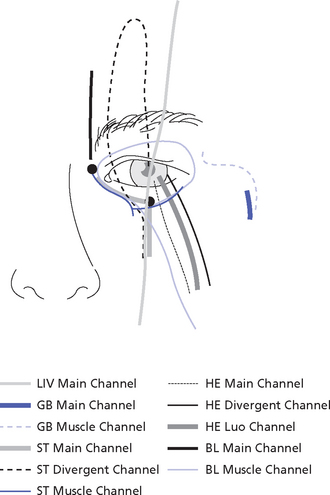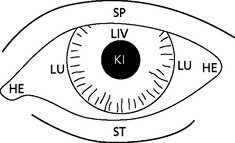Chapter 6 From a Five-Element perspective, the eyes are the outlet of the Liver. Chapter 4 of the ‘Simple Questions’ says: ‘The East direction corresponds to the colour green and the Liver which opens into the orifice of the eyes.’1 However, many other organs influence the eyes and, particularly from a diagnostic point of view, the eyes reflect the state of all the Internal Organs and therefore of the Mind and Spirit. In particular, the eyes reflect the state of the Mind and Spirit because of the close connection between the Eyes and the Heart. In fact, Chapter 81 of the ‘Simple Questions’ says: ‘The Heart transports the Essence of the five Yin organs to the eyes; if the eyes are brilliant and with lustre, it shows that the person is happy and Qi is harmonious. If, on the contrary, the eyes lack lustre it indicates that the person is afflicted by worry and this is reflected in the brilliance of the eyes.’2 The same chapter says: ‘The Spirit and the Essence of the Heart gather in the eyes.’3 However, as mentioned above, many other organs also influence the eyes. Chapter 4 of the ‘Spiritual Axis’ says: ‘Qi and Blood of the twelve channels and of the fifteen Connecting channels reach the orifices of the face so that the Yang-Qi brightens the eyes’.4 Chapter 71 of the same book says: ‘By observing the five colours of the eyes, one can determine the state of the five Yin organs and therefore the prognosis.’5 Therefore, as we can see, the essences and fluids of all the Internal Organs nourish and moisten the eyes: for this reason, the eyes can reflect the state of most Internal Organs and not just the Liver, to which they are related within the Five-Element scheme of correspondences. The ‘Spiritual Axis’ in Chapter 80 says: The Essence of the five Yin and six Yang organs all reach the eyes which are the ‘nest’ of the Essence. The Essence of the bones [and therefore of the Kidneys] manifests in the pupil; the Essence of the sinews [and therefore of the Liver] manifests in the iris; the Essence of Blood [and therefore of the Heart] manifests in the blood vessels and the canthus [of the eye]; the Essence of Qi [and therefore of the Lungs] manifests on the sclera; the Essence of the muscles [and therefore of the Spleen] manifests in the eyelids; therefore, the Essence of bones, sinews, blood and Qi together with the blood vessels form the Eye System which goes upwards entering the brain and backwards exiting at the nape of the neck.6 This statement from the ‘Spiritual Axis’ is important in two ways. First, it establishes a connection between the Internal Organs and the five parts of the eye that are called the Five Wheels. The Five Wheels are the pupil (corresponding to the Kidneys), the iris (corresponding to the Liver), the sclera (corresponding to the Lungs), the two corners of the sclera (corresponding to the Heart) and the eyelids (corresponding to the Spleen). Secondly, this chapter of the ‘Spiritual Axis’ describes an ‘Eye System’ composed of all the channels reaching the eye which enter the brain and exit at the nape of the neck. The same chapter of the ‘Spiritual Axis’ also says: The eyes manifest the Essence of the five Yin and six Yang organs, the Nutritive and Defensive Qi, and they are the place where the Qi of the Mind is generated … the eyes are the messengers of the Heart which houses the Mind. If the Mind and Essence are not co-ordinated and not transmitted one has visual hallucinations. The Mind, Ethereal Soul and Corporeal Soul are scattered so that one has bewildering perceptions.7 In conclusion, in diagnosis the eyes reflect the state of all the organs and of the Mind and Spirit. The various pathological colours of the sclera will be discussed and, finally, various other signs appearing in the eyes will be discussed. (Please note that many more signs related to the eyes are discussed in Part 5 Symptoms and Signs, Chapter 61.) The channels coursing through or around the eyes are illustrated in Figure 6.1. The pathways of the channels coursing through or around the eyes are as follows: The relationship between the eyes and the Liver is, of course, very well known owing to the Five-Element correspondence. The Liver-Blood nourishes the eyes and produces normal vision. For example, the ‘Spiritual Axis’ in Chapter 17 says: ‘Liver-Qi reaches the eyes, when the Liver is harmonized the eyes can distinguish the five colours.’8 It also says: ‘The Liver stores Blood which allows us to see.’9 The ‘Simple Questions’ in Chapter 5 says: ‘The Liver governs the eyes;’10 and in Chapter 4: ‘The East corresponds to the green colour and the Liver which opens into the eyes.’11 Liver-Yin also nourishes the eyes and, more specifically, it moistens them: in fact, dry eyes are often a symptom of Liver-Yin deficiency, while blurred vision is a symptom of Liver-Blood deficiency. The ‘Spiritual Axis’ in Chapter 10 says: ‘The Heart channel connects with the Eye System.’12 In Chapter 11 it says: ‘The Divergent channel of the Heart connects with the Eye System.’13 The same chapter also says: ‘The Heart channel reaches the face and connects with the inner canthus of the eye.’14 Therefore, Heart-Blood also nourishes the eye in a similar way to Liver-Blood, or, to put it differently, for Blood to reach the eye it needs the transporting action of Heart-Qi. The ‘Simple Questions’ also mentions the connection between the eye and the Heart in several places and Chapter 81 says: ‘The Spirit and the Essence of the Heart gather in the eye.’15 It also says: ‘The Heart is the focus of the Essence of the five Yin organs and its orifice is the eye.’16 The ‘Spiritual Axis’ in Chapter 80 says: ‘The eye is the ambassador of the Heart.’17 The Stomach channel is closely connected to the eye as it starts just under the orbit of the eye. It transports the Food Essences to the eyes. The Spleen influences the eyelids and the muscles that control their opening and closing. Chapter 62 of the ‘Spiritual Axis’ says: ‘Stomach-Qi flows upwards to the Lungs and on to the head via the throat and connects with the Eye System and from here enters the brain.’18 Chapter 31 of the ‘Simple Questions’ says: ‘The Bright Yang controls the muscles and its channel flows to the nose and eyes.’19 Chapter 21 of the ‘Spiritual Axis’ says: ‘The leg Bright Yang channel goes to the nose, the mouth and enters the Eye System.’20 Both the Divergent and the Muscle channels of the Stomach enter the eye. Chapter 13 of the ‘Spiritual Axis’ says: ‘The Muscle channel of the Stomach … connects with the Greater Yang channel which controls the upper eyelid, while the Bright Yang channel controls the lower eyelid.’21 However, the prevalent view is that the Spleen controls both eyelids. The Gall-Bladder channel is closely connected to the eye as it starts at its outer corner. Chapter 10 of the ‘Spiritual Axis’ says: ‘The Gall-Bladder channel starts from the lateral corner of the eye.’22 Chapter 11 of the same book says: ‘The Gall-Bladder Divergent channel … scatters on the face, enters the Eye System and joins the Main channel at the external corner of the eye.’23 Chapter 13 says: ‘The Muscle channel of the Gall-Bladder … binds around the external corner of the eye.’24 Thus, both the Divergent and the Muscle channel of the Gall-Bladder reach the eye. The Bladder channel starts at the inner corner of the eye. Its influence on the eye is a close one. Chapter 10 of the ‘Spiritual Axis’ says: ‘The Bladder channel starts at the inner corner of the eye.’25 The Bladder Muscle channel is wrapped around the eye socket. Chapter 21 of the same book says: ‘The leg Greater Yang channel penetrates the occiput, enters the brain, it connects with the eye and is called the Eye System.’26 Chapter 10 of the ‘Spiritual Axis’ says: ‘A branch of the Small Intestine channel departing from the clavicle, goes to the neck and cheek to reach the lateral corner of the eye … another branch reaches the nose and arrives at the inner corner of the eye.’27 The Muscle channel of the Small Intestine also reaches the outer corner of the eye. Box 6.1 and Figure 6.2 summarizes the relationships between the Internal Organs and the eyes. The ‘Five Wheels’ is an ancient expression to indicate five areas of the eyes: the pupil, iris, corners of the sclera, the rest of the sclera and the eyelids. These Five Wheels are the Water Wheel, the Wind Wheel, the Blood Wheel, the Qi Wheel and the Muscle Wheel respectively. Figure 6.3 illustrates the Five Wheels. The Five Wheels are as follows: The significance of the Five Wheels is that it establishes a physiological relationship between those five parts of the eye and the Internal Organs. For example, the pupil pertains to the Kidneys and if it is excessively dilated it may indicate Kidney-Yang deficiency; the iris pertains to the Liver and its inflammation may indicate Liver-Heat; the sclera pertains to the Lungs and a change in its colour or texture may indicate a Lung pathology such as Lung-Heat; the corners of the eye pertain to the Heart and a redness there may indicate Heart-Fire; the eyelids pertain to the Stomach and Spleen and if, for example, they are drooping this may indicate sinking of Spleen-Qi, while if they are swollen and red they indicate Spleen-Heat. However, as always in the Chinese medicine system of correspondences, there are pathologies which escape such correspondences; for example, a redness of the sclera may be related to Heat in any organ and not just the Lungs. The ‘Eight Ramparts’ are another way of classifying areas of the eye in relation to the Internal Organs. The classification according to the Eight Ramparts is broadly the same as that according to the Five Wheels, except that it is more detailed, especially in relation to the sclera, which is divided into three areas corresponding to the Lungs, Minister Fire and Triple Burner. (Fig. 6.4).
 OBSERVATION OF THE EYES
OBSERVATION OF THE EYES
INTRODUCTION
CHANNELS INFLUENCING THE EYES
RELATIONSHIP BETWEEN THE INTERNAL ORGANS AND THE EYES
The eyes and the Liver
The eyes and the Heart
The eyes and the Stomach and Spleen
The eyes and the Gall-Bladder
The eyes and the Bladder
The eyes and the Small Intestine
The Five Wheels
The Eight Ramparts
![]()
Stay updated, free articles. Join our Telegram channel

Full access? Get Clinical Tree


OBSERVATION OF THE EYES




